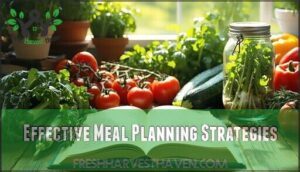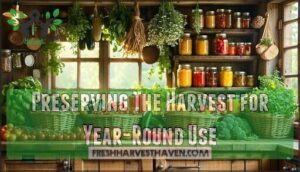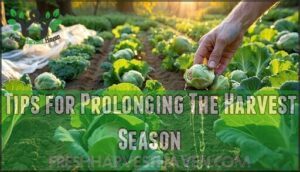This site is supported by our readers. We may earn a commission, at no cost to you, if you purchase through links.
 You’re juggling soccer practice, work deadlines, and that mountain of laundry, but your garden’s bursting with fresh veggies.
You’re juggling soccer practice, work deadlines, and that mountain of laundry, but your garden’s bursting with fresh veggies.
Here’s the thing – garden to table recipes for busy families don’t need to be complicated.
Think simple sheet pan dinners with your homegrown zucchini, or tossing fresh tomatoes into a quick pasta sauce.
Your kids won’t even realize they’re eating "healthy" when you sneak those garden greens into smoothies or quesadillas.
The secret isn’t fancy cooking skills – it’s knowing which recipes work when you’ve got exactly twelve minutes before someone melts down.
Smart shortcuts can transform your harvest into weeknight magic.
Table Of Contents
- Key Takeaways
- Benefits of Garden to Table
- Overcoming Challenges of Using Homegrown Produce
- Effective Meal Planning Strategies
- Preserving The Harvest for Year-Round Use
- Favorite Garden to Table Recipes
- Quick and Easy Garden to Table Meals
- Garden to Table Recipes for Busy Families
- Gardening Tips for a Bountiful Harvest
- Creative Ways to Use Homegrown Produce
- Sharing The Garden to Table Lifestyle
- Frequently Asked Questions (FAQs)
- What to cook for large family gatherings?
- What is the best food to feed a crowd of 20 people?
- What is a good dinner to make for a lot of people?
- What is easy to make to feed a crowd?
- How long can fresh-picked vegetables last in the fridge?
- Which vegetables are easiest to grow with kids?
- Can you freeze herbs from the garden?
- What garden tools are essential for beginners?
- How to handle pest damage on homegrown vegetables?
- How to involve kids in garden-to-table cooking?
- Conclusion
Key Takeaways
- Let your garden dictate your menu – Check what’s ready to harvest first, then plan meals around peak-ripeness produce for maximum flavor and minimal waste.
- Master simple preservation techniques – Freeze blanched vegetables for 8-12 months, dehydrate herbs for concentrated flavor, and learn basic pickling to extend your harvest year-round.
- Embrace one-pot meals and 30-minute recipes – Sheet pan dinners, stir-fries, and quick pasta dishes using fresh garden vegetables keep weeknight cooking stress-free for busy families.
- Start with kid-friendly vegetables – Grow radishes, cherry tomatoes, and lettuce that children can easily harvest and enjoy eating, making them excited participants in your garden-to-table journey.
Benefits of Garden to Table
When you grow your own vegetables and cook with them right away, you’re giving your family the freshest, most nutritious meals possible.
While saving serious money on groceries is a significant benefit, it’s not the only advantage of growing your own vegetables.
Plus, there’s nothing quite like the satisfaction of watching your kids actually get excited about eating carrots they helped pull from the dirt that morning!
Health Benefits of Homegrown Produce
The magic of homegrown produce transforms your family’s health in remarkable ways.
When you grow your own vegetables, you’re controlling what goes into your soil and onto your plate—no mysterious chemicals or long transport times that strip away precious nutrients.
Your garden-fresh flavors pack serious nutrient density that store-bought veggies simply can’t match.
Fresh from your garden means maximum nutrition hits your plate—no long transport times stealing those precious vitamins away.
Here’s what makes homegrown produce a game-changer for family nutrition:
- Pesticide reduction means cleaner eating and better gut health for everyone
- Peak freshness delivers maximum vitamins and minerals straight to your table
- Waste reduction turns imperfect produce into nutritious meals instead of trash
Financial Benefits of Garden to Table
Your grocery bill savings add up fast when you grow your own ingredients.
Fresh tomatoes in July? Free instead of five bucks a pound. That’s real family budget impact right there.
Seasonal eating costs practically nothing when you’re harvesting what’s ready. Reducing food waste becomes easier too—you’ll use every carrot and cucumber because you grew them yourself.
This homegrown investment pays off with garden to table meals that taste amazing and cost pennies.
Emotional Benefits of Growing Own Food
While saving money feels great, the emotional benefits of growing your own food run much deeper than your wallet.
There’s pure gardening joy in watching tiny seeds transform into dinner. You’ll discover that tending plants offers incredible stress reduction—it’s like having a therapist in your backyard! Your hands in the soil, your mind finds peace.
Family bonding happens naturally when everyone pitches in. Kids love picking cherry tomatoes, and those shared moments create lasting memories. You’ll feel deep gratitude when serving meals made from your own harvest.
Growing food builds genuine self-sufficiency. There’s something magical about knowing you can feed your family from your own efforts. This gratitude cultivation extends beyond meals—it touches how you view abundance and appreciate simple pleasures.
Homegrown produce benefits your emotional wellbeing just as much as your physical health, creating connections between effort and nourishment.
- Daily meditation: Garden time becomes your peaceful escape from busy family life
- Pride multiplier: Every homegrown meal feels like a small victory worth celebrating
- Legacy building: You’re teaching kids valuable life skills while creating family traditions
Overcoming Challenges of Using Homegrown Produce
You’ve got this amazing garden bursting with fresh veggies, but somehow you’re still ordering pizza because you can’t figure out what to do with all those zucchini.
Let’s tackle the real challenges that keep busy families from making the most of their homegrown bounty, so you can turn those garden wins into delicious weeknight dinners, and make the most of your delicious harvest.
Shifting Mindset to Prioritize Homegrown Produce
Your garden-to-table journey starts with a simple mindset flip that’ll transform your family meals forever.
Let seasonal availability guide your menu instead of fighting it. Check your garden inventory first, then plan meals around what’s ready to harvest. Fresh ingredients taste amazing, so you won’t miss store-bought produce.
- Embrace imperfection: Those wonky tomatoes and curved carrots pack incredible flavor
- Reduce waste: Turn leftover greens into tomorrow’s smoothies or soups
- Focus on family enjoyment: Grow what your kids actually love eating for quick recipes
Planning Meals Based on Available Produce
Smart meal planning starts with your garden inventory—what’s actually ready to harvest? Check your plot weekly and build seasonal recipes around what’s thriving.
Your family preferences matter too, so adapt quick recipes to match their tastes. Fresh ingredients shine when you plan ahead, turning today’s harvest into tomorrow’s dinner.
What’s Ripe Quick Meal Ideas
Seasonal cooking reduces waste while sparking creativity!
Adapting Recipes to Suit Homegrown Ingredients
Recipe flexibility becomes your best friend when homegrown produce doesn’t match what’s written on the page.
Master ingredient substitution by swapping store-bought items for seasonal cooking treasures from your backyard. That expensive basil? Use your garden’s oregano instead. Missing bell peppers? Grab those fresh tomatoes ripening on the vine.
- Waste minimization: Transform overripe tomatoes into pasta sauce or use wilted greens in smoothies
- Flavor enhancement: Fresh ingredients pack more punch than their store-bought counterparts
- Seasonal swaps: Replace winter vegetables with summer harvests for garden to table recipes that work year-round
Your busy families deserve meals that celebrate homegrown produce!
Effective Meal Planning Strategies
You’ve got your garden bursting with fresh veggies, but you’re standing in your kitchen wondering what to cook – sound familiar?
Smart meal planning turns that overwhelming harvest into your secret weapon for getting dinner on the table fast, and it’s easier than you think, making fresh veggies a key part of your meal planning strategy.
Creating a Recipe List by Vegetable
Once you’ve tackled the mindset shift, organizing your vegetable recipe index becomes your secret weapon for stress-free meal planning.
Create ingredient-based menus by listing each veggie you grow, then jot down three favorite recipes for each one.
This simple system transforms overwhelming harvest bounty into easy dinners and quick meals your family actually wants to eat.
Your adaptable recipe templates make weeknight dinners practically plan themselves!
Prioritizing Recipes With Fresh Ingredients
One simple trick transforms your kitchen: prioritize fresh ingredients over everything else.
Your seasonal recipe lists become your best friend when you let the garden dictate dinner.
That tomato bursting with flavor? It deserves center stage, not some wilted store-bought substitute.
Ingredient-based planning means you’re cooking what’s perfectly ripe today.
Recipe adaptation becomes second nature—swap basil for oregano if that’s what’s thriving.
This approach minimizes waste while creating garden to table recipes that deliver quick meals your family actually craves.
Weekly Meal Planning for Efficient Harvest Use
Your garden’s bounty doesn’t have to overwhelm you when meal planning becomes your secret weapon. Start with a Harvest Inventory each week—check what’s ready to pick and what needs using first. This simple step prevents those "oops, the tomatoes went bad" moments we’ve all had.
Recipe Prioritization means matching meals to what’s ripening now. Got mountains of zucchini? Plan three zucchini-based meals this week. Seasonal Adaptations keep things fresh while Family Preferences guarantee everyone actually eats what you’re serving.
- Create flexible weeknight dinners that swap ingredients based on harvest timing
- Batch prep garden vegetables Sunday for quick assembly during busy weeknights
- Plan one "clean out the fridge" meal weekly to minimize Waste Reduction
These timesaving tips transform garden to table recipes into stress-free solutions for busy families.
Preserving The Harvest for Year-Round Use
You know that amazing feeling when your garden explodes with more tomatoes and zucchini than your family can eat in a week?
Learning simple preservation tricks like freezing, dehydrating, and canning turns that overwhelming abundance into your secret weapon for quick, healthy meals all winter long, utilizing quick methods to preserve your harvest.
Freezing and Dehydrating Homegrown Produce
Two proven Freezing Techniques help busy families enjoy homegrown produce year-round.
Blanching Methods preserve nutrients—just dip vegetables in boiling water for 2-3 minutes, then ice bath them quickly.
Dehydrator Types range from basic countertop models to advanced units with temperature controls.
Preserving harvest through freezing retains 95% Nutrient Retention, while dehydrating concentrates flavors beautifully.
Many prefer dehydrating to freezing because it enhances flavor profiles.
Storage Duration varies: frozen veggies last 8-12 months, dehydrated herbs stay fresh 6-8 months.
Both methods guarantee longterm freshness that’ll make winter meals taste like summer’s bounty.
Fermenting and Canning Methods
Three preservation methods will transform your garden surplus into pantry gold. Canning lets you stockpile tomatoes and beans safely—just follow proper canning safety guidelines. Fermenting veggies creates probiotic powerhouses like sauerkraut. Jam making turns berries into breakfast magic.
For safe canning, it’s important to follow tested recipes to avoid spoilage.
- Master basic pickling techniques for crisp cucumbers and tangy carrots
- Learn fermentation benefits for gut-healthy foods that last months
- Follow tested preserve recipes to avoid spoilage disasters
Preserving harvest means year-round garden flavors!
Future Guides on Preservation Techniques
Your kitchen’s about to become a food preservation powerhouse! Advanced Freezing techniques will transform how you store summer’s bounty. Innovative Dehydration methods turn fresh herbs into flavor bombs. Fermentation Mastery creates tangy treats that’ll make your taste buds dance.
Here’s what’s coming your way:
| Technique | What You’ll Learn |
|---|---|
| Canning Innovations | Modern pressure canning and water bath methods |
| Modern Pickling | Quick refrigerator pickles and fermented favorites |
| Food Storage | Smart containers and freezer organization tricks |
You’ll master freezing, dehydrating, fermenting, and canning like a pro!
Favorite Garden to Table Recipes
You’ve worked hard to grow those gorgeous tomatoes and crisp cucumbers, so let’s turn them into meals your family will actually eat.
These tried-and-true recipes make the most of your garden’s bounty without spending hours in the kitchen, because who’s time for that when there’s weeding to do?
Tomato-Based Recipes for Summer
Nothing beats the magic of fresh tomatoes turning ordinary meals into summer masterpieces.
Your garden-to-table approach transforms simple recipes into quick dinners that’ll make everyone smile.
Try chilled gazpacho recipes for those scorching afternoons, or whip up bruschetta variations that disappear faster than you can make them.
Fresh ingredients from your backyard create the most flavorful tomato salads and summer sauces you’ve ever tasted.
- Gazpacho magic: Blend tomatoes with herbs for instant cool-down soup
- Bruschetta brilliance: Top crusty bread with diced tomatoes and basil
- Sauce superstar: Simmer fresh tomatoes into rich, tomatobased recipes
Zucchini and Summer Squash Recipes
Swimming in zucchini and summer squash? You’re not alone!
Transform your harvest into Zucchini Noodles for guilt-free pasta nights. Stuffed Zucchini boats filled with cheese and herbs create kidfriendly meals everyone loves.
Grill thick slices for smoky Grilled Squash perfection, or try delicate Squash Blossoms sautéed with garlic.
Blend into creamy Summer Soups for cooling comfort. These simple recipes turn fresh ingredients into vegetable recipes that busy families actually want to eat!
Radish, Cucumber, and Leafy Green Recipes
While zucchini steals summer’s spotlight, your radish recipes and cucumber recipes deserve equal attention.
Radish Relishes add crunch to sandwiches, while Cucumber Coolers refresh hot afternoons.
Transform leafy green recipes into quick Green Smoothies or Leafy Wraps for lunch.
Simple Pickling turns surplus radishes into tangy treats.
These garden to table solutions help busy families create fresh meals without fuss.
For example, fresh spinach provides calcium for better bone health.
Quick and Easy Garden to Table Meals
You don’t need hours in the kitchen to turn your garden’s bounty into something delicious.
With a few simple tricks, you can whip up fresh, flavorful meals faster than your kids can ask, “What’s for dinner?”
One-Pot Wonders With Homegrown Ingredients
You’ve discovered amazing garden to table recipes that celebrate your harvest.
Now let’s tackle the reality of weeknight cooking chaos with one-pot meals that’ll save your sanity.
Minimal cleanup meets maximum flavor when you combine homegrown produce in a single pot. Your fresh tomatoes, zucchini, and herbs create nutrient retention magic while you’re juggling homework help and laundry.
Versatile vegetables adapt beautifully to stir-fries, casseroles, and quick soups. Toss whatever’s ready from your garden into one pan—carrots, peppers, leafy greens—and watch busy families gather around family favorites that actually taste homemade.
These easy recipes using homegrown produce prove that one-pot meals don’t sacrifice quality for convenience. Your garden works harder so you don’t have to.
30. Minute Meals From Garden to Table
Quick garden meals don’t require culinary magic—just fresh ingredients and smart timing! Fast harvest recipes like zucchini noodle stir-fry or roasted veggie pasta transform your bounty into speedy seasonal cooking winners.
These simple garden dinners prove that efficient garden cuisine works perfectly for busy families.
For maximum flavor, remember to preserve seasonal produce to use in later dishes.
With 30-minute meals using homegrown produce, you’ll create satisfying family meals that taste amazing and save precious time.
Simple Salads and Sandwiches
Nothing beats simple salads and sandwiches when you’re racing against dinnertime.
Your garden’s bounty transforms into quick, satisfying meals that’ll make everyone happy. Fresh ingredients from your backyard create magic in minutes—no fancy techniques required.
- Leafy Green Salads: Toss mixed greens with whatever’s ripe for instant nutrition
- Garden Tomato Sandwiches: Layer thick tomato slices with mayo and herbs on crusty bread
- Herb Salad Dressings: Blend fresh basil or dill with olive oil for zesty flavor
- Cucumber Ribbon Sandwiches: Use a peeler to create elegant cucumber ribbons for tea-style treats
- Radish Toasts: Top buttered bread with sliced radishes and sea salt
Garden to Table Recipes for Busy Families
You’re juggling soccer practice, homework help, and somehow need dinner on the table by six – sound familiar?
These garden-to-table recipes work magic for busy families, turning your homegrown veggies into meals that’ll have everyone asking for seconds.
Without keeping you stuck in the kitchen all evening, they provide a convenient solution for busy families to enjoy homegrown meals.
Kid-Friendly Meals With Homegrown Produce
When your little ones turn their noses up at vegetables, it’s time to get creative! Transform fresh produce into exciting adventures they can’t resist.
Mini veggie pizzas let kids become chefs, choosing colorful toppings from your garden. Garden stir-fries with fun shapes make dinner playful.
Try zucchini recipes disguised as "noodles" – they’ll never know! Create recipe challenges where kids design their own tomato salads.
These garden to table recipes prove that kid-friendly meals don’t require sneaky tactics. Fresh produce becomes the star when presented with imagination and a dash of fun.
Meals for Special Diets and Restrictions
Kids aren’t the only ones with special needs at dinnertime.
Your garden’s bounty makes creating allergy-friendly meals and gluten-free options surprisingly simple. Fresh vegetables naturally accommodate most special diets without fancy substitutions or expensive specialty ingredients.
Here’s how your homegrown harvest transforms into inclusive family meals:
- Gluten-free zucchini noodles replace pasta while delivering fresh flavor and nutrients
- Vegan garden recipes showcase vegetables as satisfying main courses, not side dishes
- Diabetic-friendly choices emphasize low-carb vegetables that won’t spike blood sugar
- Low-sodium dishes rely on herbs and spices instead of salt for bold taste
Recipes for Large Families and Gatherings
Feeding twelve people doesn’t have to stress you out.
These garden to table recipes scale up beautifully for large families and gatherings. Batch cooking becomes your best friend with crowd-pleasing dishes like zucchini fritters and garden pasta salad. Make freezer meals ahead of time for easy entertaining.
| Potluck Recipes | Buffet Ideas |
|---|---|
| Caprese Salad | Tomato Bruschetta |
| Cucumber Sandwiches | Zucchini Fritters |
| Garden Pasta Salad | Fresh Herb Dips |
Your homegrown ingredients shine in these family-friendly recipes that’ll have everyone asking for seconds!
Gardening Tips for a Bountiful Harvest
You don’t need a green thumb to grow amazing vegetables that’ll fill your family’s dinner table all season long!
With the right plants for your area and some smart growing tricks, you’ll have so much fresh produce that your biggest problem will be figuring out what to cook first.
Choosing The Right Vegetables for Your Climate
Your Hardiness Zones hold the secret to garden success!
Check your zone first—it determines which climate-appropriate vegetables will thrive.
Consider sunlight needs (tomatoes crave full sun), soil types (carrots love sandy dirt), and watering needs.
Don’t forget regional pests—choose resistant varieties to save yourself headaches.
Smart home gardening means matching plants to your environment.
These gardening tips transform struggling plots into abundant harvests for your family’s table.
Effective Gardening Methods for Homegrown Produce
Choosing climate-appropriate vegetables sets you up for success, but effective gardening methods turn potential into plenty.
Start with Soil Health—mix compost into beds like you’re folding chocolate chips into cookie dough.
Try Companion Planting for natural Pest Control: basil loves tomatoes, and marigolds repel aphids better than harsh chemicals.
Vertical Gardening maximizes small spaces—think trellised cucumbers climbing skyward.
Don’t forget Seed Saving from your best plants; it’s like keeping family recipes alive.
To improve your garden’s output, consider using specialized soil products.
These gardening tips guarantee your homegrown produce feeds your family year-round.
Tips for Prolonging The Harvest Season
You’ve got your garden growing strong, but why stop there? Season extension keeps your family fed longer with smart tricks.
Succession planting spreads out harvests so you’re not drowning in tomatoes one week and starving the next. Cold frames and row covers act like cozy jackets for plants when Jack Frost comes knocking.
You can also concentrate sugars for flavor by allowing frost to enhance sweetness and flavor intensity in root vegetables.
Here’s your roadmap for prolonging harvest:
- Succession planting every 2-3 weeks for continuous crops
- Cold frames protect tender plants from early frost
- Row covers extend growing season by 4-6 weeks
- Crop rotation maintains soil health for better yields
- Harvest calendar plans preservation timing perfectly
Creative Ways to Use Homegrown Produce
You’ve got baskets of fresh tomatoes, bunches of herbs, and maybe some surprise zucchini that grew overnight—now what?
Let’s turn that garden bounty into amazing snacks, desserts, and flavor-packed meals that’ll make your family forget all about store-bought anything.
Using Homegrown Herbs in Recipes
With your herb garden flourishing outside your kitchen window, you’re sitting on a goldmine of flavor that’ll transform even the simplest recipes.
Homegrown herbs pack more punch than store-bought alternatives, making your garden to table recipes sing with vibrant taste. Fresh herbs bring life to busy families’ weeknight dinners.
- Herb flavor pairings: Match basil with tomatoes, rosemary with potatoes, and sage with chicken for foolproof combinations
- Fresh vs. dried: Use fresh herbs at the end of cooking, while dried herbs can handle longer cooking times
- Herb infused oils: Blend herbs with olive oil for instant flavor boosters
- Simple recipes: Even scrambled eggs become gourmet with fresh chives
Incorporating Homegrown Produce Into Snacks
Nothing beats turning your backyard bounty into irresistible garden snack ideas that’ll have your busy families asking for more.
Transform crisp cucumbers and sweet carrots into colorful veggie sticks – perfect kid-friendly snacks that crunch with every bite.
Your cherry tomatoes become instant pop-in-your-mouth treats, while zucchini slices bake into golden chips rivaling any store-bought version.
These seasonal snack recipes prove that healthy snack swaps don’t mean sacrificing taste.
Supporting local growers guarantees superior taste and nutrition.
Involving kids in washing and prepping homegrown produce makes snack time a fun garden to table adventure everyone loves.
Using Homegrown Produce in Desserts
Your garden’s sweet side deserves attention! Homegrown produce creates amazing desserts that’ll make your family’s taste buds dance.
Transform your harvest into these Sweet Garden Treats:
- Fruity Dessert Recipes: Fresh berry cobblers and seasonal fruit tarts burst with flavor
- Vegetable Dessert Ideas: Moist carrot cake and chocolate zucchini brownies surprise everyone
- Herb Infused Sweets: Mint ice cream and lavender cookies add sophisticated twists
- Kid-approved treats: Simple fruit parfaits perfect for cooking with kids
Even vegetables become dessert stars!
Sharing The Garden to Table Lifestyle
When you’ve mastered the garden-to-table lifestyle, you’ll naturally want to share this amazing journey with friends and family who might be struggling with their own meal planning.
You’ll find that spreading the word about homegrown goodness isn’t just about recipes—it’s about building a community that supports each other through the ups and downs of growing food and getting dinner on the table every night, which is a key part of the garden-to-table lifestyle.
Inspiring Others to Adopt Garden to Table
Your enthusiasm for garden to table living becomes contagious when you share it authentically. Fresh produce from your backyard tells a story that busy families can relate to – especially when you show them how simple healthy eating can be.
Here’s how to inspire others without overwhelming them:
- Start small conversations at school programs or community gardens about your family’s favorite quick meals using homegrown vegetables.
- Share honest social media posts showing both successes and failures, helping others see that overcoming obstacles is part of the journey.
- Invite neighbors over for casual dinners featuring your fresh produce, letting the flavors speak for themselves while encouraging family involvement.
Sharing Recipes and Gardening Tips With Community
Transform your passion into a community movement by sharing recipes and gardening wisdom with neighbors.
Join local gardening clubs where seed sharing becomes second nature, or organize recipe swaps that’ll have everyone talking.
Community gardens offer perfect spots for impromptu workshops—teach someone to pickle cucumbers or share your famous zucchini bread recipe.
Online forums connect you with fellow enthusiasts beyond your zip code.
Post photos of tonight’s harvest-to-plate creation and watch the comments roll in.
Your sharing lifestyle creates ripples of inspiration, turning one green thumb into dozens across your neighborhood.
community connections
homegrown produce use
creative meal ideas
Building a Support Network for Garden to Table
Creating your garden-to-table support network transforms solo gardening into a thriving community adventure.
You’ll discover that sharing your journey makes everything more rewarding and fun.
Here are four ways to build meaningful community connections:
- Join Local Gardening Clubs for hands-on mentorship opportunities and seasonal advice.
- Participate in Seed Swap Events to diversify your garden while meeting fellow enthusiasts.
- Connect through Online Garden Forums for year-round support and recipe sharing.
- Volunteer at Community Gardens to learn new techniques while inspiring others.
Frequently Asked Questions (FAQs)
What to cook for large family gatherings?
Feeding a crowd doesn’t have to stress you out.
Try sheet pan meals like roasted vegetables with chicken, slow cooker pulled pork, or one-pot soups that stretch easily and keep everyone happy.
What is the best food to feed a crowd of 20 people?
Like hosting a neighborhood block party, you’ll want hearty crowd-pleasers that stretch your budget.
Think slow-cooker pulled pork, big pasta salads, sheet-pan fajitas, and chili.
These dishes feed many without breaking the bank.
What is a good dinner to make for a lot of people?
Sheet pan meals are your lifesaver.
Toss chicken, vegetables, and seasonings on one pan, then roast everything together.
Everyone gets fed, you get minimal cleanup, and dinner’s ready in thirty minutes flat.
What is easy to make to feed a crowd?
One-pot meals save your sanity when hosting crowds.
Try slow cooker pulled pork, sheet pan fajitas, or big batches of chili.
You’ll spend less time cooking and more time enjoying your guests’ company, with complete concepts like these helping to make hosting easier.
How long can fresh-picked vegetables last in the fridge?
Time’s a thief in the case of fresh vegetables.
Your garden treasures typically stay crisp for 3-10 days refrigerated, depending on the type.
Leafy greens wilt fastest, while root vegetables hang tough longer.
Which vegetables are easiest to grow with kids?
Radishes, lettuce, and beans are perfect starter vegetables for kids.
They grow quickly, need minimal care, and kids love watching them sprout.
Carrots and cherry tomatoes also work well since children enjoy harvesting and eating them fresh, and they are great examples of quickly growing plants that kids can enjoy.
Can you freeze herbs from the garden?
Yes, you can absolutely freeze herbs.
Wash them gently, pat dry, then freeze whole in bags or chop and freeze in ice cube trays with oil.
They’ll keep their flavor for months.
What garden tools are essential for beginners?
Like a chef needs sharp knives, you’ll need basic garden tools to succeed.
Start with a sturdy spade, hand trowel, pruning shears, and watering can.
These four essentials will handle most beginner tasks perfectly, with the sturdy spade being a fundamental tool.
How to handle pest damage on homegrown vegetables?
Don’t panic when pests attack your vegetables! Inspect plants daily, remove damaged portions immediately, and harvest what’s salvageable. You can still use partially affected produce by cutting away damaged areas.
How to involve kids in garden-to-table cooking?
Studies show kids who help cook eat 76% more vegetables.
Start with simple washing tasks, then graduate to tearing lettuce or mixing salads.
Let them pick tomorrow’s garden harvest—ownership makes them excited to eat what they’ve grown and prepared.
Conclusion
Picture your neighbor’s jaw dropping when you casually mention whipping up dinner from vegetables you picked twenty minutes ago.
That’s the magic of garden to table recipes for busy families – transforming chaos into something wonderful.
You’ve got the tools now: simple techniques, smart shortcuts, and recipes that actually work on hectic weeknights.
Your family will taste the difference, your wallet will thank you, and you’ll wonder why you waited so long to start this delicious adventure.
- https://thebusybaker.ca/easy-sheet-pan-steak-fajitas/
- https://inquiringchef.com/20-minute-chicken-ramen-stir-fry/
- https://babyfoode.com/blog/pulled-pork-sandwiches-with-apple-slaw/
- https://www.nytimes.com/wirecutter/blog/keep-your-produce-fresh/
- https://www.housebeautiful.com/lifestyle/a39775440/ways-to-make-your-home-more-sustainable/















